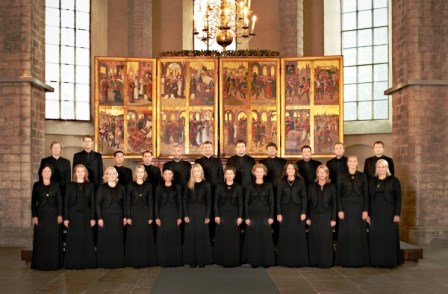“Great Music in a Great Space” describes the annual choral
concert series at Cincinnati's St. Peter in Chains Cathedral perfectly.

The word “great” was amplified even further Tuesday evening with the appearance of the Estonian Philharmonic Chamber Choir, one of the world’s greatest vocal ensembles.
Led by artistic director/chief conductor Daniel Reuss, the 26-voice, award winning choir opened the Cathedral’s 2013-14 season with music by Estonian composers, including Arvo Pärt, one the world’s best known contemporary classical composers.
Also on the program was music by Mart Saar (1882-1963),
Cyrillus Kreek (1889-1962) and Veljo Tormis (1930- ). It was a mixture of sacred
and secular that kept listeners thoroughly engaged, both by its beauty and its freshness.
Estonia, a country of 1.3 million, has one of the richest folk music traditions in the world. Add to that its famous laulupidud (song festivals) held every fifth year, universal music education and you get the idea. (The country’s freedom from Soviet occupation in 1991 was spurred by its song festivals in what is now called “The Singing Revolution.”)
The concert began with Mart Saar’s folk-derived "Noore veljo, veeritage" “Young Brethren, Sing!” an exuberant invitation to song that got the evening off to a rousing start. Saar’s "Seitse sammeldanud sängi" (“Seven Moss-Grown Beds”), a recital of the country’s history of suffering (slavery, war, famine) drawn from Estonia’s national epic “Kalevipoeg,” was eloquently sung.
Kreek, who like Bartok in Hungary, collected and recorded thousands of Estonian folk songs, was well represented on the program. His lively "Sirisege, sirbikesed" (“Sing, Sickles!") (1919), a staple of Estonian song festivals, sparkled. The men of the choir lent their burnished sound to "Lauliku omaksed" (“Singer’s Kinsfolk”) (1955), while "Talvine õhtu" “Wintry Night” (1921) for the full choir was faraway and reflective.
Kreek’s three Psalms of David (1923) included a fervent plea for help (Psalm 22), a song of praise with a gentle “Amen” (Psalm 104) and a compilation from Psalms 1-3, " Õnnis on inimene" “Blessed is the Man.”
A highlight of the concert was Tormis’ Jaanilaulud (1967), a set of songs for St. John’s Day, or Midsummer’s Eve, an important holiday in Estonia, observed by the lighting of bonfires and night-long celebrations. The set, drawn from different parishes in the country, began with a call to the bonfire, sung wordlessly at the beginning, with two women singing offstage. No. 6, a fire incantation ("Tulesõnad") was delivered in speech song, which built to a frantic pitch. The set ended with a merry tilling song, ("Jannilaul") calling on “Janni” to bring good luck.
Works by Pärt were heard on the second half, beginning with his soft, serene “Da pacem Domine” (2006) a lovely example of his deeply affecting, neo-modal “tintinnabuli” style (the choir’s album of the same name won a Grammy for best choral performance in 2007). His 1989 Magnificat was filled with humility, while his two Slavonic Psalms (1984/1997, sung in Slavonic) expressed majesty and humble reflection.
The concert ended with Pärt’s “Dopo la vittoria” (1998) on an Italian text describing the origin of the Ambrosian hymn “Te Deum,” a joyous account which called for an encore, Kreek’s “My Heart, Awaken.”
The Estonian Philharmonic Chamber Choir last appeared in Cincinnati (at St. Peter in Chains) in 2008, led by its founding director Tõnu Kaljuste. One looks forward to their return again soon.
Next up for "Great Music in a Great Space" is the annual Advent carol service Dec. 1, sung by the choir of St. Peter in Chains led by Cathedral music director Anthony DiCello. For a complete guide to the season, which will feature tenor Marco Panuccio, Stile Antico and Chanticleer, visit www.stpeterinchainscathedral.org